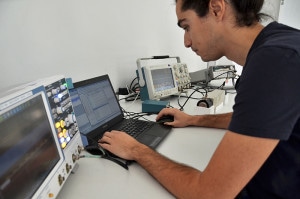Jun 3 2016
Scientists have devised a new method that enables a non-invasive way to assess the damages caused to different types of materials and helps determine the general state-of-repair in real time. This latest breakthrough will assist in preventing possible safety issues. The study was carried out by scientists at the Universitat Politècnica de València.
 (Credit: Universitat Politècnica de València)
(Credit: Universitat Politècnica de València)
Based on sophisticated signal processing methods, the non-invasive technique investigates the determinism of signals received from the ultrasonic analysis of the materials under test. Poetical damages are indicated by alterations in this parameter. By operating at various frequency ranges, the materials’ internal structure can be determine and the level of damages can be measured more accurately than using conventional methods.
This technique is patented by the UPV and is more competitive than present-day techniques, like measuring attenuation and velocity. This technique has numerous benefits, for intone, it helps estimate of the overall damages caused to the material. Moreover, the measurement parameter is standardized from 0 to 1, thereby making it easier to comprehend the results.
This technique could have manifold applications, like in aeronautics, and motor and naval engineering for ongoing observation of fuselage. In this division, it is important to regularly confirm the condition of the airplane wings, hulls, car bodyworks, etc, as these components carry heavy loads and are subject to fatigue cycles; there might also be sudden changes in pressure and temperature.
Additionally, this novel technique could be utilized to identify damages in bridges, examine resistant elements and pillars in buildings, and evaluate construction defects caused by natural calamities, or deterioration in the marine surroundings in the field of construction and civil engineering.
State monitoring of industrial locations, analysis of energy transportation systems, like gas or oil pipelines, and quality control of 3D printing components are other potential applications of this technique.
Also, this finding leads to advances in non-invasive tests, making these tests independent of the calibration of the unit as well as the material being tested.
The study is the result of a joint association between scientists at the Concrete Science and Technology Institute (ICITECH) and the Institute for Telecommunications and Multimedia Applications (iTEAM), both from the Universitat Politècnica de València (UPV).
Source: http://ruvid.org/